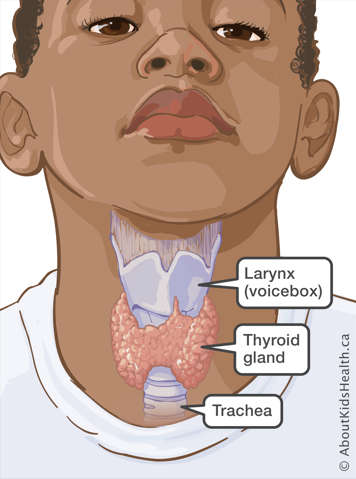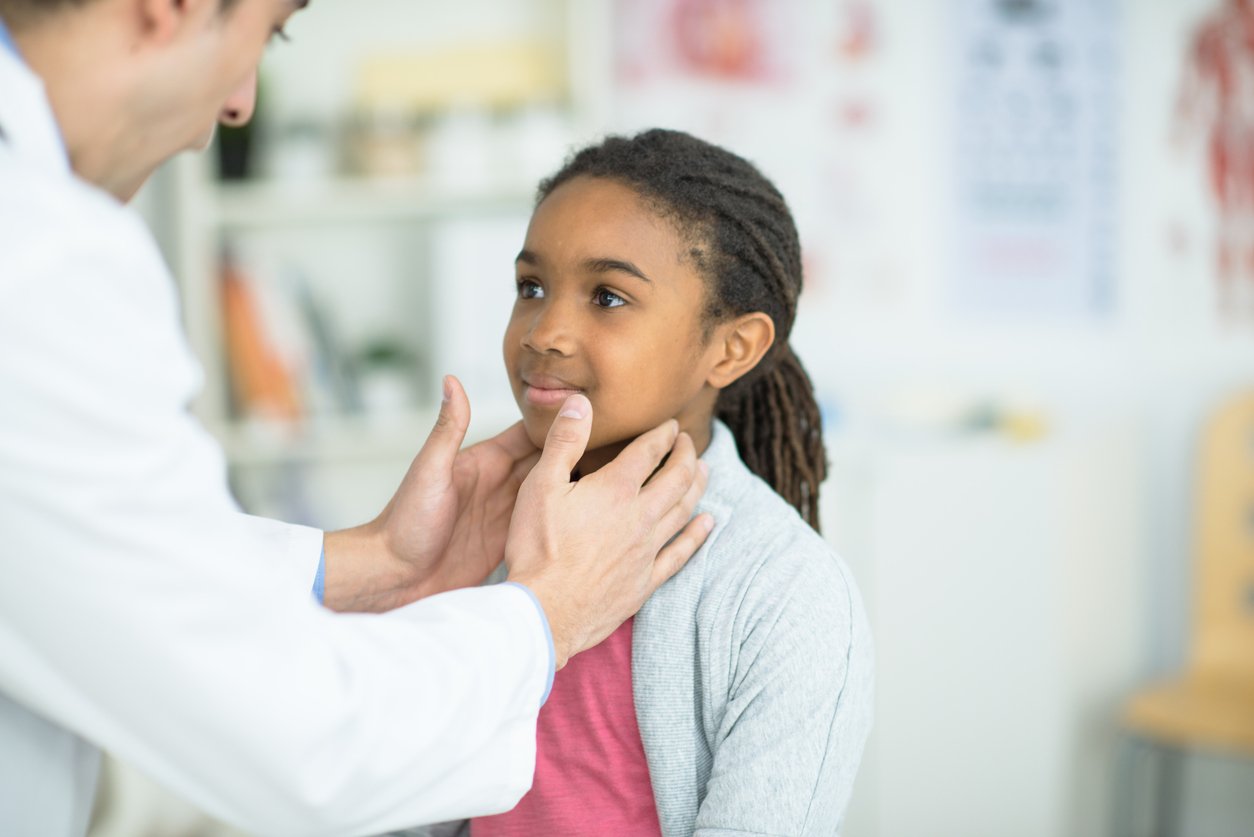What is congenital hypothyroidism?
Hypothyroidism is a condition where the thyroid gland does not produce enough thyroid hormone. "Congenital" means present at birth.
Congenital hypothyroidism can happen when the thyroid gland is missing, is in the wrong place, is smaller than usual, or is not working properly and has decreased or absent hormone production. Most of the time congenital hypothyroidism happens by chance and results from an abnormality that occurs before birth.
Congenital hypothyroidism occurs in 1 in 3000 children born in Ontario.
What is the thyroid gland?

The thyroid gland is a butterfly shaped gland that sits at the base of the neck. As a fetus grows in the uterus, thyroid cells start developing on the tongue and then move to their final position at the base of the neck. The thyroid gland makes hormones that are important for normal growth and development of the body and brain.
What is thyroid hormone?
Thyroid hormones are responsible for metabolism and are essential for growth and brain development. The first few years of life are the most critical time for thyroid hormone replacement, if a child needs it. At this time, connections in the brain are rapidly forming. By age 3, a child’s brain has reached 80% of its adult volume. Babies born with congenital hypothyroidism grow up to be healthy adults when treated early and are treated correctly.
How does the thyroid gland work?
The thyroid gland is part of a complicated messaging system to regulate the body’s metabolism. The brain has a built-in sensor called the pituitary gland that senses the level of thyroid hormone. The pituitary gland releases a hormone called thyroid stimulating hormone (TSH). TSH then directs the thyroid gland to make thyroid hormone (thyroxine), also called T4, for the body’s needs. If the thyroid gland makes too little thyroxine, then the level of TSH rises to stimulate the thyroid gland to make more thyroid hormone. This is what happens in congenital hypothyroidism.
Alternatively, if the thyroid gland makes too much thyroxine, then the pituitary gland, will cut down the production of TSH. An elevated TSH could mean there is not enough thyroid hormone circulating in the body and a low TSH means there may be too much thyroid hormone circulating in the body.
How is congenital hypothyroidism diagnosed?
Congenital hypothyroidism is usually diagnosed during a newborn screening test done shortly after birth while your baby is still in the hospital. The blood test is done as a heel poke and will look for high levels of TSH.
What is the treatment for congenital hypothyroidism?
Treatment for congenital hypothyroidism involves replacing the missing thyroid hormone. Levothyroxine is a synthetic hormone medication which is identical to the thyroxine produced by the body and restores thyroid hormone levels to normal. Levothyroxine is taken by mouth daily, to maintain steady blood levels, and should be taken on an empty stomach (if possible) around the same time each day. If you forget, give it as soon as possible and return to your regular schedule the next day. If you do not remember until the next day, give only that day’s dose and do not double up. A missed dose is not an emergency and is generally well tolerated however, to maintain stable thyroid levels and well-being it is important to minimize missed doses.
For infants who are unable to swallow whole pills, you can crush the tablet and give the medication on the tip of a moist finger placed inside the infant’s mouth. Taking the medication with soy-based or iron-rich infant formulas may decrease the absorption in the body, however, thyroid tests will be checked frequently and adjustment to doses made as needed.
If your child is taking iron supplements or antacids while taking levothyroxine, the thyroid medication should be taken at least 4 hours apart from those medications. Your health-care team can help you plan this into your daily routine.
Levothyroxine does not interfere with immunizations.
How long will my child need to take levothyroxine?
Most children with congenital hypothyroidism will need to continue taking levothyroxine for their entire lives because their thyroid problem is permanent. Children will require increased amounts of levothyroxine as they grow and develop. In some children, between 1 and 3 years of age, their health-care provider may stop the levothyroxine for a brief period as a trial to see if the hypothyroidism was temporary. This is done by measuring thyroid blood tests. The medication may need to be restarted, depending on the results of the blood tests.
Signs and symptoms of under or over treatment
As your child grows, they may require a higher dose of levothyroxine. It is often hard to tell when your child needs a higher dose, as they may not show any signs or symptoms. That is why it is important to do the blood tests as recommended by your doctor. The only way to know when to make changes to your child’s medication is by completing a blood test.
As thyroid levels fluctuate it is also possible for your child to receive more thyroid hormone medication than needed. Some of the things you may see if your child is getting too little or too much thyroid hormone include:
| Hypothyroidism | Hyperthyroidism |
|---|---|
| Too little thyroid hormone (not enough thyroid medication) | Too much thyroid hormone (too much thyroid medication) |
|
|
You may notice these symptoms 1-2 months after starting the medication or after a dose change. If you see the signs listed above, contact your health-care team.
General guidelines for recommended bloodwork and clinic visits
- Further bloodwork/additional visits may be needed in between.
- Transfer to a community based pediatric endocrinologist closer to your home will be arranged.
| Visits | Bloodwork | Clinic visits |
|---|---|---|
| 1st visit | x | x |
| 2-3 weeks after starting meds | x | x |
| Age 2 months | x | |
| Age 3 months | x | x |
| Age 6 months | x | x |
| Age 9 months | x | |
| Age 12 months | x | x |
| Age 15 months | x | |
| Age 18 months | x | x |
| Age 2 years | x | x |
| Age 2.5 years | x | |
| Age 3 years | x | x |
| Age 4 years | x | x |
| Age 5 years | x | x |
Bloodwork result log
| Date | TSH | Free T4 | Dosage change? | Comments |
|---|---|---|---|---|
